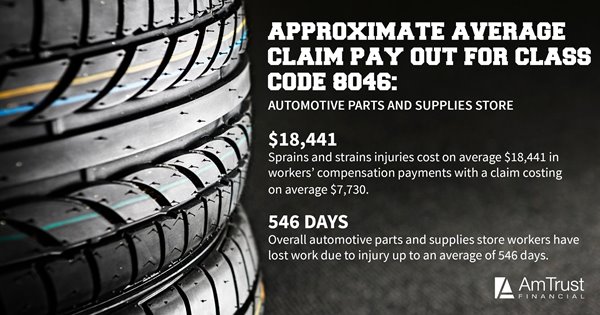Summary: Auto parts and supply stores are a booming business, but employees in this industry face various risks, from lifting and handling materials to cutting open boxes of new stock. Learn what employers can do to ensure workers stay safe on the job. Helping Auto Parts and Supply Store Employees Avoid Risks
There are
over 43,000 automobile parts and supply stores in the U.S selling everything from floor mats and windshield wipers to batteries and brake pads. In 2022, auto parts stores experienced 1.7% business growth throughout the country. The industry includes retailers of new and used car parts in both single-location and multi-location companies, though this business class does not include stores that sell and install tires. These types of
retail stores contain a vast amount of inventory, which can increase the risks that lead to employee injuries.
The success of retail and wholesale operations is based on the movement and storage of products either on a sales floor or in a backroom or warehouse. Automobile parts and supply stores display products in various places inside their buildings: on shelves, hanging on fixtures or in boxes in large stacks. They also keep additional stock in warehouses where it often has to be accessed by ladders and moved by forklifts. Auto supply stores also may rely on drivers to deliver parts to repair shops and dealerships.
By implementing proper safety measures, automobile parts and supply store owners can have peace of mind that they are protecting both their customers and employees.

What are Common Hazards in Automotive Parts and Supplies Stores?
The job duties of auto parts store employees include moving items of all sizes, climbing ladders to reach stock and loading heavy parts into cars for customers. Along with these activities, some of the common hazards employees face in auto supplies stores include:
- Lifting and handling materials
- Housekeeping and maintenance
- Ladders and step ladders
- Hazardous materials and chemicals
- Knives, box cutters and sharp instruments
- Rack/storage safety-ranging from shelf installation injuries to falling merchandise to falls from heights
- Packaging, unpacking boxes and stocking products
The greatest exposure to risk is due to the delivery of auto parts. Delivering parts often involves navigating unfamiliar parking lots or workplaces where drivers could be unaware of potential dangers. Drivers have significant exposures that can lead to a host of claims for the physical damage of the vehicles involved and the potential injuries to the drivers (and other drivers), passengers and pedestrians.

Auto Parts Stores Injuries
A Center for Disease Control study found that the most common injuries across all types of retail stores include sprains and strains, cuts/lacerations, punctures, bruises, contusions and fractures, no matter the type of retail operation. Similar to the rest of the retail industry, auto parts and supplies store employees exhibit sprains and strains more often in their workers’ compensation claims. The two leading exposures contributing to injuries were contact with objects and overexertion. The part of the body most impacted by these injuries was the trunk, which includes shoulders, back and abdomen.

Safety Tips to Reduce Risks in Automobile Parts and Supplies Stores
Reducing risks in your automobile parts and supplies store starts by looking for potential hazards and training your employees in safe work habits. Auto supply stores should follow the same safety guidelines as any retail store including
ladder safety and
slips and falls prevention. Many of the risks in these stores are closely aligned to those found in
hardware stores and
warehouses, however, there are additional risks, including auto parts delivery driver safety that must be considered.
Safety Guidelines for Auto Parts and Supply Drivers
Safe driving practices must be followed by all delivery drivers. It’s imperative that diligent driver screening and Motor Vehicle Records (MVR) review is in place. Driver MVRs must be reviewed at least every six months. Unacceptable drivers must not be allowed to operate a company vehicle.
Routine driver safety practices must also be followed including:
- Permit only trained & properly licensed individuals to drive specialized vehicles
- Check tires, lights, horn, and brakes of company vehicles before driving; repair or replace as needed
- Be aware of the distribution of the cargo weight (shifting loads may cause loss of control)
- Do not exceed the maximum speed limit or drive under posted minimum speed limit
- Pull over safely to the side of the road when making or receiving a cellular phone call

Workers’ Compensation Insurance for Auto Supply and Parts Stores
Automotive parts and supply stores, including
auto repair shops, are just one of the business classes that AmTrust writes. Protect your employees with
workers’ compensation coverage and
loss control services from AmTrust Financial. For more information, please
contact us today.
This material is for informational purposes only and is not legal or business advice. Neither AmTrust Financial Services, Inc. nor any of its subsidiaries or affiliates represents or warrants that the information contained herein is appropriate or suitable for any specific business or legal purpose. Readers seeking resolution of specific questions should consult their business and/or legal advisors. Coverages may vary by location. Contact your local RSM for more information.